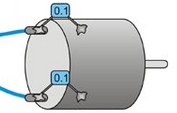Support » Application Note: Using the Motor Driver on the 3pi Robot and Orangutan Robot Controllers »
9. Dealing with Motor Noise
One major drawback to working with motors is the large amounts of electrical noise they produce. This noise can interfere with your sensors and can even impair your microcontroller by causing voltage dips on your regulated power line. Large enough voltage dips can corrupt the data in microcontroller registers or cause the microcontroller to reset.
The main source of motor noise is the commutator brushes, which can bounce as the motor shaft rotates. This bouncing, when coupled with the inductance of the motor coils and motor leads, can lead to a lot of noise on your power line and can even induce noise in nearby lines.
There are several precautions you can take to help reduce the effects of motor noise on your system:
 |
1) Solder capacitors across your motor terminals. Capacitors are usually the most effective way to suppress motor noise, and as such we recommend you always solder at least one capacitor across your motor terminals. Typically you will want to use anywhere from one to three 0.1 µF ceramic capacitors, soldered as close to the motor casing as possible. For applications that require bidirectional motor control, it is very important that you do not use polarized capacitors!
If you use one capacitor, solder one lead to each of the motor’s two terminals as shown to the right above.
 |
For greater noise suppression, you can solder two capacitors to your motor, one from each motor terminal to the motor case as shown in the picture to the right.
For the greatest noise suppression, you can solder in all three capacitors: one across the terminals and one from each terminal to the motor case.
2) Keep your motor and power leads as short as possible. You can decrease noise by twisting the motor leads so they spiral around each other.
3) Route your motor and power wires away from your signal lines. Your motor lines can induce currents in nearby signal lines. We have observed voltage spikes as high as 20 V induced in completely separate circuits near a noisy motor.
4) Place decoupling capacitors (also known as “bypass capacitors”) across power and ground near any electronics that you want to isolate from noise. The closer you can get them to the electronics, the more effective they will be, and generally speaking, the more capacitance you use, the better. We recommend using electrolytic capacitors of at least several hundred µF. Note that electrolytic caps are polarized, so take care to install them with the negative lead connected to ground and the positive lead connected to VIN, and make sure you choose one with a voltage rating high enough to tolerate the noise spikes you are trying to suppress. A good rule of thumb is to select one that is rated for at least twice your input voltage.








